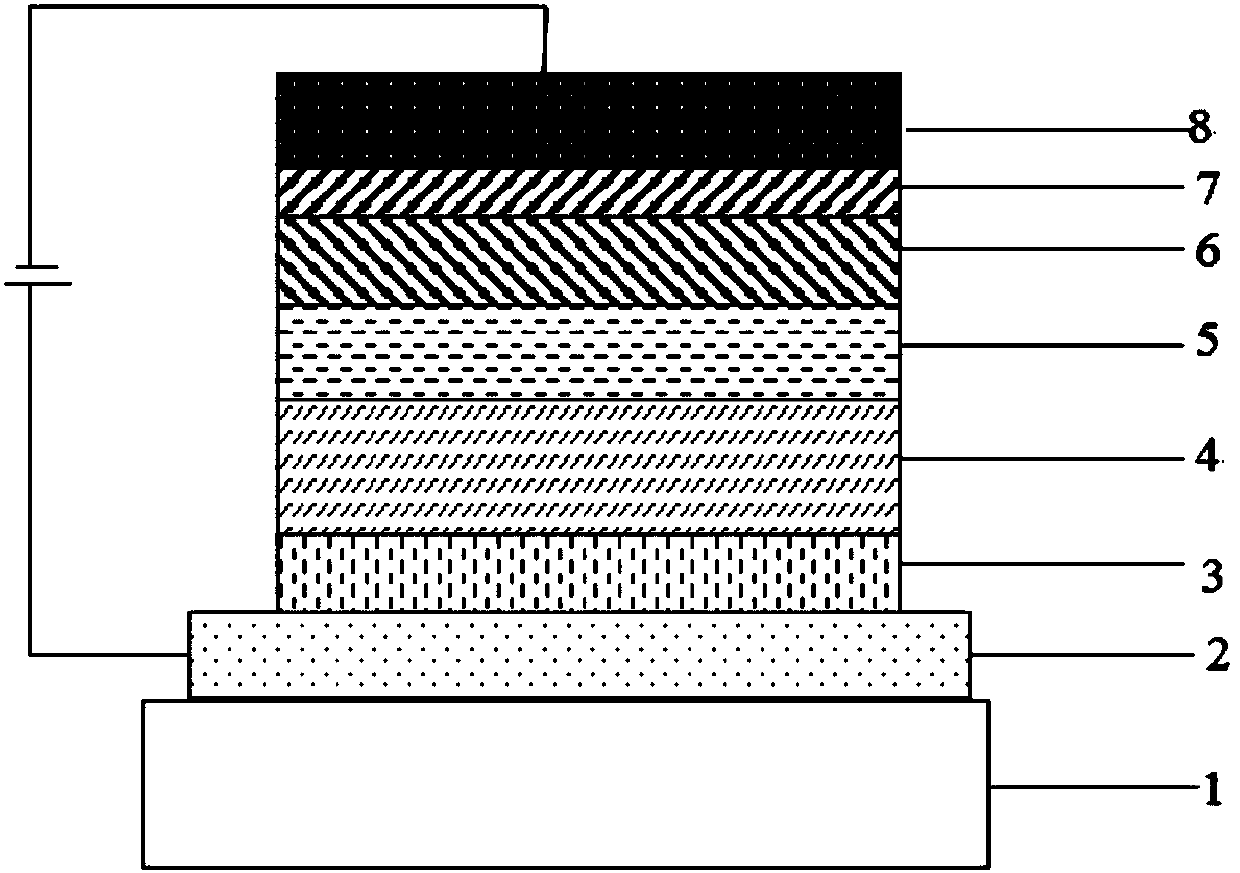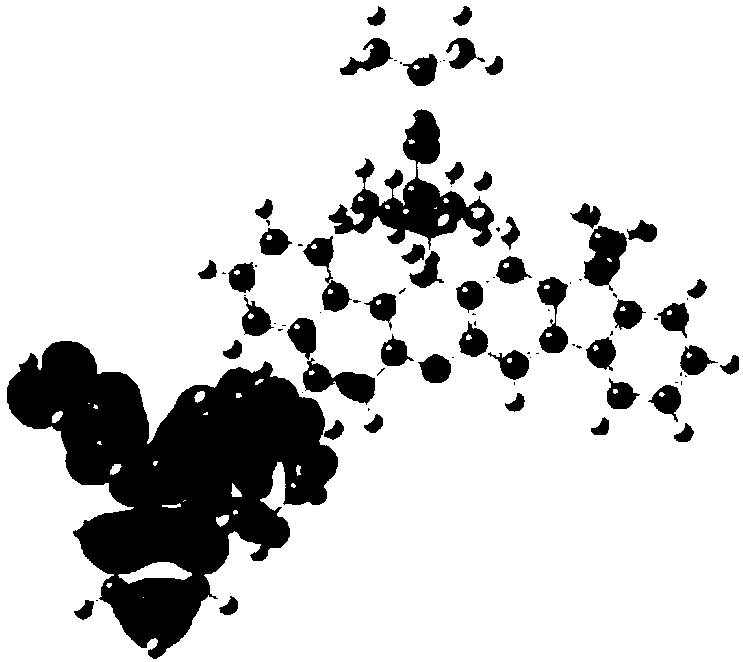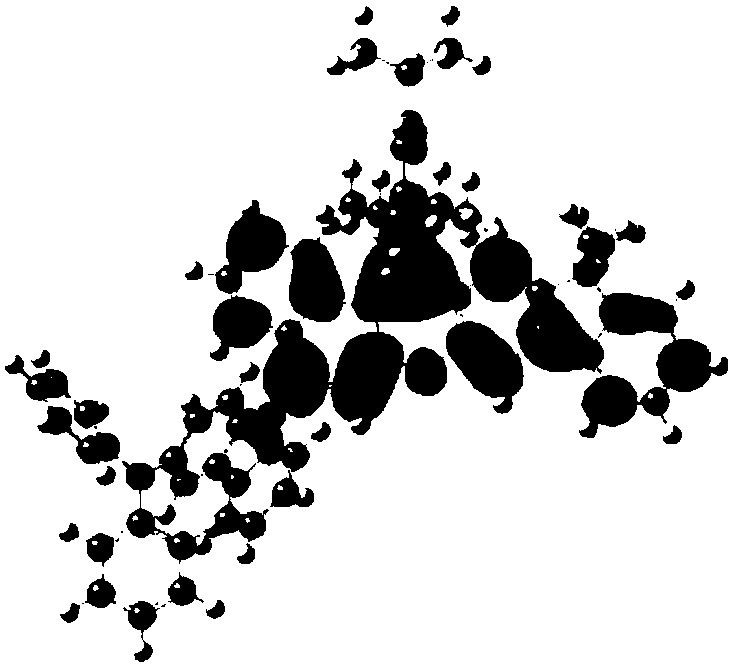Boron-containing multi-element heterocyclic organic compound and application thereof to OLED (organic light-emitting diode) device
An organic compound and multi-component technology, applied in the field of semiconductors, can solve the problems of efficiency roll-off, high exciton utilization rate, high fluorescence radiation efficiency, low S1 state radiation transition rate, etc., and achieve good photoelectric performance.
- Summary
- Abstract
- Description
- Claims
- Application Information
AI Technical Summary
Problems solved by technology
Method used
Image
Examples
Embodiment 1
[0063] The synthesis of embodiment 1 compound 5
[0064] The synthetic steps of compound are as follows:
[0065]
[0066]
[0067] Add 0.01mol 2,5-dibromofluorobenzene, 0.012mol M1, 0.02mol sodium carbonate and 10ml ethylene glycol dimethyl ether into a 50ml three-neck flask, pass through nitrogen protection, heat to 190 degrees Celsius, and stir for 48 hours. Then cool to room temperature, pour into a beaker, add 50ml of toluene and 50ml of water and stir for 20 minutes. After filtration, the filtrate was rotary evaporated and passed through a silica gel column to obtain a white intermediate 1a with a purity of 98.60% and a yield of 80.5%. HRMS(m / z): [M+H] + , the theoretical value is 523.06, and the measured value is 523.10.
[0068] In a 200ml three-necked flask, add 0.01mol of intermediate 1a and 50ml of diethyl ether, stir to dissolve, blow nitrogen, cool the system to -10°C, and slowly add 0.02mol of n-butyl lithium hexane solution dropwise under nitrogen atmos...
Embodiment 2
[0070] The synthesis of embodiment 2 compound 10
[0071] The synthetic steps of compound are as follows:
[0072]
[0073]
[0074] Add 0.01mol E1, 0.012mol M1, 0.02mol sodium carbonate and 10ml ethylene glycol dimethyl ether into a 50ml three-neck flask, pass through nitrogen protection, heat to 190 degrees Celsius, and stir for 48 hours. Then cool to room temperature, pour into a beaker, add 50ml of toluene and 50ml of water and stir for 20 minutes. After filtration, the filtrate was rotary evaporated and passed through a silica gel column to obtain the white intermediate 2a with a purity of 97.60% and a yield of 65.8%. HRMS(m / z): [M+H] + , the theoretical value is 573.11, and the measured value is 573.07.
[0075] In a 200ml three-necked flask, add 0.01mol of intermediate 2a and 50ml of diethyl ether, stir to dissolve, blow nitrogen, cool the system to -10°C, and slowly add 0.02mol of n-butyl lithium hexane solution dropwise under nitrogen atmosphere, and the addi...
Embodiment 3
[0077] The synthesis of embodiment 3 compound 20
[0078] The synthetic steps of compound are as follows:
[0079]
[0080]
[0081] Add 0.01mol 2,5-dibromofluorobenzene, 0.012mol M2, 0.02mol sodium carbonate and 10ml ethylene glycol dimethyl ether into a 50ml three-neck flask, pass through nitrogen protection, heat to 190 degrees Celsius, and stir for 48 hours. Then cool to room temperature, pour into a beaker, add 50ml of toluene and 50ml of water and stir for 20 minutes. After filtration, the filtrate was rotary evaporated and passed through a silica gel column to obtain a white intermediate 3a with a purity of 98.10% and a yield of 77.5%. HRMS(m / z): [M+H] + , the theoretical value is 496.89, and the measured value is 496.84.
[0082] In a 200ml three-necked flask, add 0.01mol of intermediate 3a and 50ml of diethyl ether, stir to dissolve, blow nitrogen gas, cool the system to -10°C, and slowly add 0.02mol of n-butyl lithium hexane solution dropwise under nitrogen at...
PUM
| Property | Measurement | Unit |
|---|---|---|
| Thickness | aaaaa | aaaaa |
| Thickness | aaaaa | aaaaa |
| Thickness | aaaaa | aaaaa |
Abstract
Description
Claims
Application Information
 Login to View More
Login to View More - R&D
- Intellectual Property
- Life Sciences
- Materials
- Tech Scout
- Unparalleled Data Quality
- Higher Quality Content
- 60% Fewer Hallucinations
Browse by: Latest US Patents, China's latest patents, Technical Efficacy Thesaurus, Application Domain, Technology Topic, Popular Technical Reports.
© 2025 PatSnap. All rights reserved.Legal|Privacy policy|Modern Slavery Act Transparency Statement|Sitemap|About US| Contact US: help@patsnap.com



